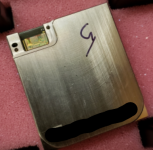I am curious, how do you see the rise of chiplets playing out here? Does it become more interesting to keep your analog on 22FDX adjacent to an N5 digital core, and will the market evolve to support specialized processes longer term via normalizing the advanced packaging?
Perhaps that adjacent path can still be analog where the N5 does not need to drive the load, have the same ESD protection, and is not operating with such a low noise requirment, so a mm or two of trace between N5 and 22FDX literally bridges their different advantages?
We already see this playing out in optics like Ayar, partly because optical gadgets are too giant to be a good use of area on a leading edge digital process, so they seem likely to settle on chiplets with optimal processes and low cost of area.
We already use 3D packaging, the 22FDX analog chips are flipped on top of a silicon photonics PIC, next to this on a common substrate is the flip-chip 5nm DSP. The RF traces between the ADC/DAC (on the DSP) and the 22FDX analog chips (on top of the PIC) are only a few mm long, bandwidth of these is >70GHz. This isn't really driven by the lower cost per mm2 of 22FDX compared to N5, but by the need to get the analog chips right next to the optical components on the PIC.
.

